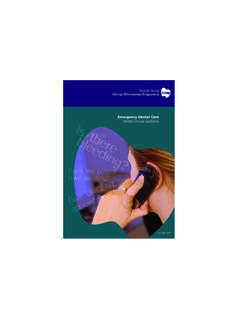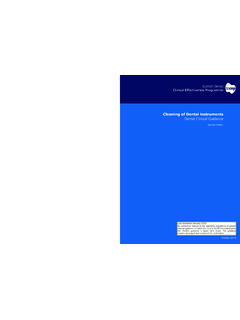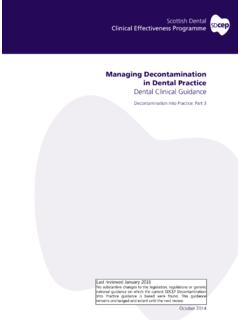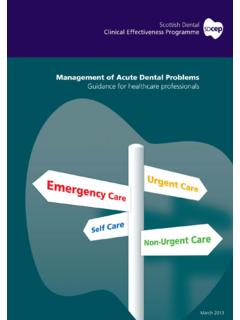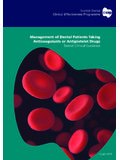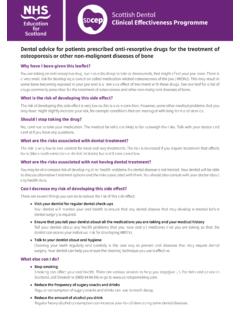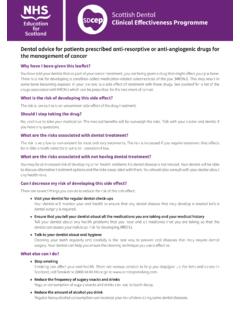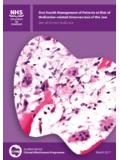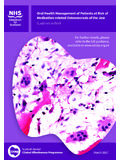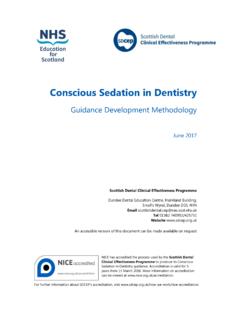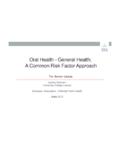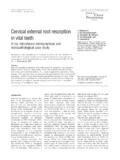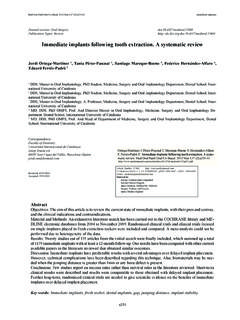Transcription of Oral Health Assessment and Review - SDCEP
1 SDCEP oral Health Assessment and Review Version May 2012 1 oral Health Assessment and ReviewDental Clinical GuidanceVersion May 2012 This document presents an update of the guidance information which was the basis for development of the short Guidance in Brief published in 2011. It is provided as a resource for those who require more detail on the background and various elements of oral Health Assessment and Review . This version may be subject to further amendment through an ongoing process of Review and updating. Feedback is welcome and can be provided via the online OHAR Forum at Comments received will be used to inform any future updating. Available to download at : Guidance in Brief Quick Reference Guide Example Recording Forms Scottish dental Clinical Effectiveness Programme Dundee dental Education Centre, Frankland Building,Small s Wynd, Dundee DD1 4 HNEmail Tel 01382 425751 / 425771 Website SDCEP oral Health Assessment and Review Version May 2012 2 SDCEP oral Health Assessment and Review Version May 2012 i 1 Introduction 1 Why this guidance has been developed 1 Why follow this guidance?
2 1 Scope of this Guidance 2 Individualised Risk Assessment 2 Supporting Tools 3 Statement of Intent 3 2 General Principles of oral Health Assessment and Review 4 What is oral Health Assessment and Review ? 4 Overarching Principles of oral Health Assessment and Review 6 Communication 6 Medico-legal Issues Relevant to oral Health Assessment and Review 7 Record Keeping 10 3 Assessment of Patient Histories 12 4 Assessment of oral Health Status 15 Assessment of the Head and Neck 15 Assessment of the oral Mucosal Tissue 16 Assessment of the Intra- oral Bony Areas 17 Assessment of the Periodontal Tissue 18 Conducting a Periodontal Examination 19 Assessment of Teeth 21 Assessment of dental Caries and Condition of Restorations 21 Assessment of Tooth Surface Loss 24 Assessment of Tooth Abnormalities 25 Assessment of Fluorosis 26 Assessment of dental Trauma 27 Occlusal Assessment 29 Orthodontic Assessment 30 Assessment of Dentures 33 5 Diagnosis and Risk Assessment 35 SDCEP oral Health Assessment and Review Version May 2012 ii Risk
3 Assessment Process 36 Identifying Modifying Factors, and Diagnosing Disease 36 Evaluating the Impact of Modifying Factors 36 Predicting Future Disease 37 Identifying the Overall Risk Level 38 Identifying a Risk-based Review Interval 38 6 Personal Care Plan and Ongoing Review 40 Developing a Personal Care Plan 41 Ongoing Review 43 7 Clinical Governance, CPD and Training 45 Recommendations for Audit 45 Recommendations for Research 45 Appendix 1 Guidance Development 46 The Scottish dental Clinical Effectiveness Programme 46 The Guidance Development Group 47 Guidance in Brief Advisory Group 47 The Programme Development Team 48 Guidance Development Methodology 48 Steering Group 49 Appendix 2 Glossary of Terms 50 Appendix 3 Roles and Responsibilities of dental Care Professionals 52 Appendix 4 Tooth Notation Systems 54 Appendix 5 Using Radiographs as a Diagnostic Aid 56 Appendix 6 Alcohol Units and Questionnaires 57 Appendix 7 Coding Caries and Restorations Using ICDAS 58 Appendix 8 Assessing Trauma 65 Appendix 9 Example Patient Record Forms 66 References 79 SDCEP oral Health Assessment and Review Version May 2012 1 1 Introduction Why this guidance has
4 Been developed Following the earlier surgical (or extractive) era, there has been a restorative approach to the provision of dental care in primary practice, with a focus on the Assessment of carious cavities in teeth and less emphasis on initial caries, the Assessment of periodontal tissue and the overall oral Health of the patient. A standard recall interval of 6 months has been advocated for all patients, regardless of the status of the patient s oral Health . However, it is becoming increasingly apparent that there are wide variations between patients in their susceptibility to disease, the likelihood of early disease progressing and the speed of disease progression, if it occurs. A one-size fits all approach is therefore not adequate to meet the needs of every patient. In 2004, the National Institute of Health and Clinical Excellence (NICE)1 issued guidance recommending that a patient s recall interval for routine care be determined by their overall risk of oral disease and thus be individualised to the needs of each patient.
5 In addition, the Scottish Government has more recently set out a Better Health , Better Care Action Plan2 that targets Health inequalities and those at greatest risk and aims to improve Health and the quality of healthcare by adopting a more preventive, proactive approach. This model is referred to as anticipatory care and aspects of it are already being implemented in dentistry within the Childsmile programme3. The intention is to extend this approach across the whole of primary dental care to move from the more traditional approach towards a more preventive, evidence-based and, where possible, minimally invasive approach to care. This approach is risk-based and long-term and aims to meet the specific needs of individual patients and encourage the involvement of patients in managing their own oral Health . The Scottish dental Clinical Effectiveness Programme ( SDCEP ) convened a guidance development group to provide clinical guidance on best practice for the Assessment of individual dental patients.
6 The Guidance Development Group defined an oral Health Assessment (OHA) as Assessment of the patient s histories and their oral Health status, leading to diagnosis and risk Assessment , followed by personalised care planning and Review . Many aspects of the guidance will be familiar to dental teams. However, the newer concepts introduced include: assessing modifying factors (including risk and protective factors, behaviours and clinical findings associated with the development of oral disease or conditions) and assigning a risk level to each patient in order to facilitate the development of a personal care plan and the identification of a recall interval for Review that is specific for each patient (see Sections 5 and 6). This guidance therefore promotes a systematic and comprehensive approach to assessing and managing the overall oral Health of each patient. Further details about SDCEP and the development of this guidance are given in Appendix 1.
7 Why follow this guidance? If a comprehensive Assessment of the patient s overall oral Health status, including Assessment of teeth, periodontal tissue, oral mucosal tissues and head and neck, is carried out for all patients, signs of oral disease can be recognised early and appropriate care (both preventive and treatment-based) can be provided to improve the oral Health , and in some cases general Health , of the patient population in Scotland. If accurate and comprehensive record keeping is carried out, this will facilitate the provision of high-quality patient care and improve patient safety, particularly in cases where patient care is shared among the dental team4. It also provides a permanent record, which can support the dental team if faced with complaints or litigation. SDCEP oral Health Assessment and Review Version May 2012 2 Scope of this Guidance This guidance aims to facilitate individualised long-term preventive-orientated care (including recall) to improve and maintain the oral Health and general Health of each patient by providing advice on patient Assessment (see Section ).
8 The guidance is based on existing guidance (NICE Clinical Guideline 19 on dental recall1, FGDP Clinical Examination and Record Keeping guideline5), relevant systematic reviews6-8, research evidence and the opinion of experts and experienced practitioners. This guidance is directed at the whole primary care dental team. The approach to patient Assessment described in this guidance is applicable to all patients, including adults, children and those with special needs, who would normally receive regular care in the primary care sector but needs to be adapted to the particular needs of specific patient groups. With the exception of some differences for the Assessment of child patients which are highlighted, details of such adaptations are beyond the scope of this version of the guidance. For patients who attend only for urgent care ( pain relief), this approach is not appropriate. Instead, a basic Assessment that enables the management of the patient s immediate needs is sufficient.
9 This should also always include taking a medical history and examination of oral mucosal tissue. Such irregular symptomatic attenders should be invited to attend for regular care, which would begin with a comprehensive OHA. The guidance does not include detailed treatment planning or specific clinical procedures. Please refer to the SDCEP guidance The Prevention and Management of dental Caries in Children 9 for more detailed advice related to child patients. This guidance describes: what oral Health Assessment and Review involves and the important overarching principles of Assessment ( effective communication, comprehensive and accurate record keeping, practising within medico-legal constraints) (see Section 2); key elements that form the examination part of patient Assessment ( Assessment of the patient histories, Assessment of oral Health status) (see Sections 3 and 4); how information from all elements of the examination is pulled together to form diagnoses and to identify the level of individual patient risk for the development and/or progression of oral disease (including other oral Health problems), which in turn informs the personal care plan and Review process (including the interval and type of Review ) (see Sections 5 and 6).
10 A glossary is provided in Appendix 2. Individualised Risk Assessment Formal individualised risk Assessment is one of the newer concepts introduced in this guidance. The guidance is therefore structured to facilitate this process. Assessment of the patient s risk of developing oral disease is an imperfect science, and requires clinical judgement and experience (often of the whole dental team) to assess and re-assess the level of risk for each individual patient (see Section 5). A range of factors need to be considered when assessing the level of risk. Within Sections 3 and 4, modifying factors, are listed in alphabetical order to facilitate risk Assessment for each patient. Modifying factors include: Risk factors that may increase the likelihood of developing oral Health problems Protective factors that can reduce the risk of developing oral disease (see Section 5). With only a few exceptions these are not listed because they are often the opposite of risk factors; for example, smoking is a risk factor whereas not smoking is a protective factor.
